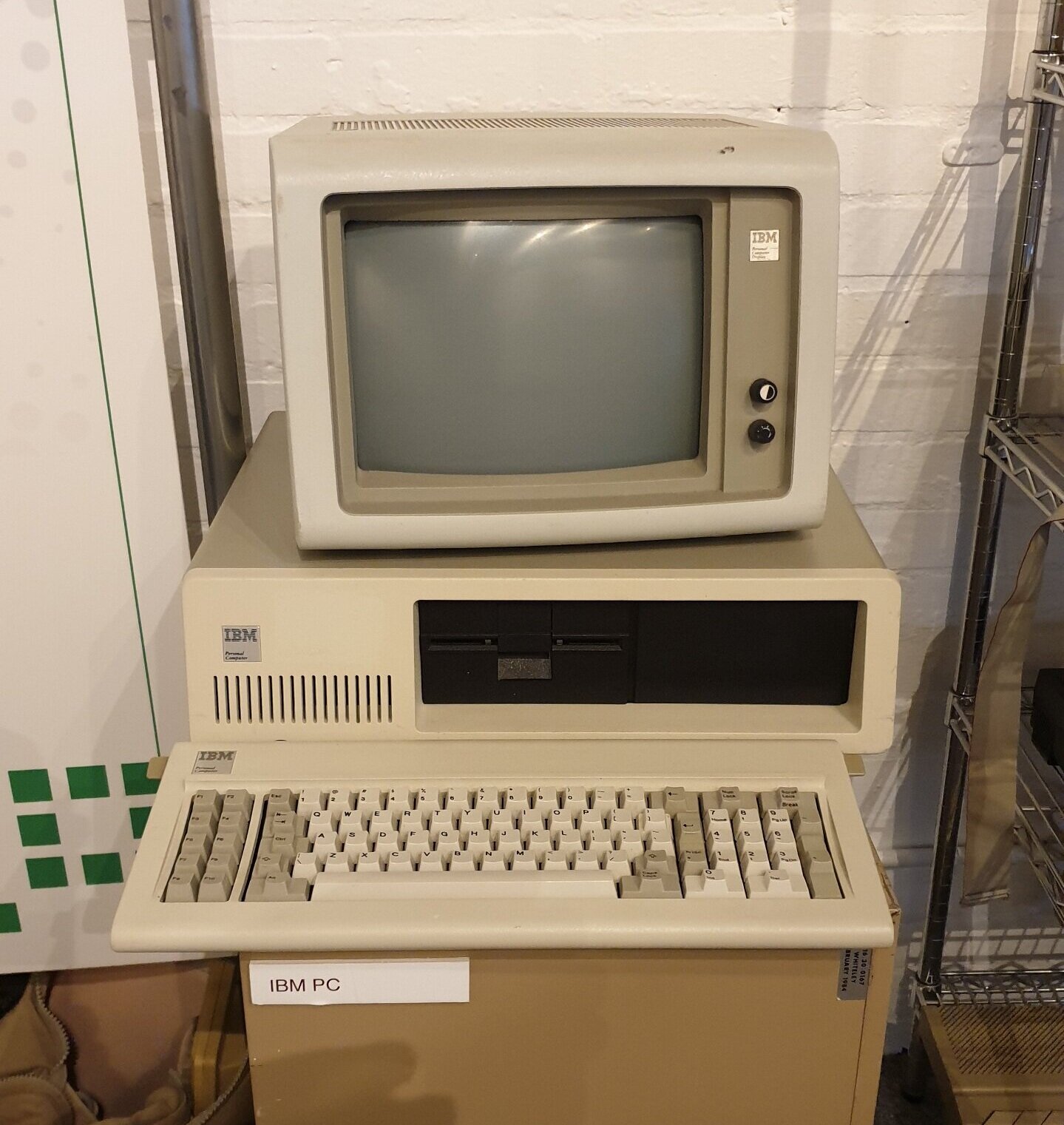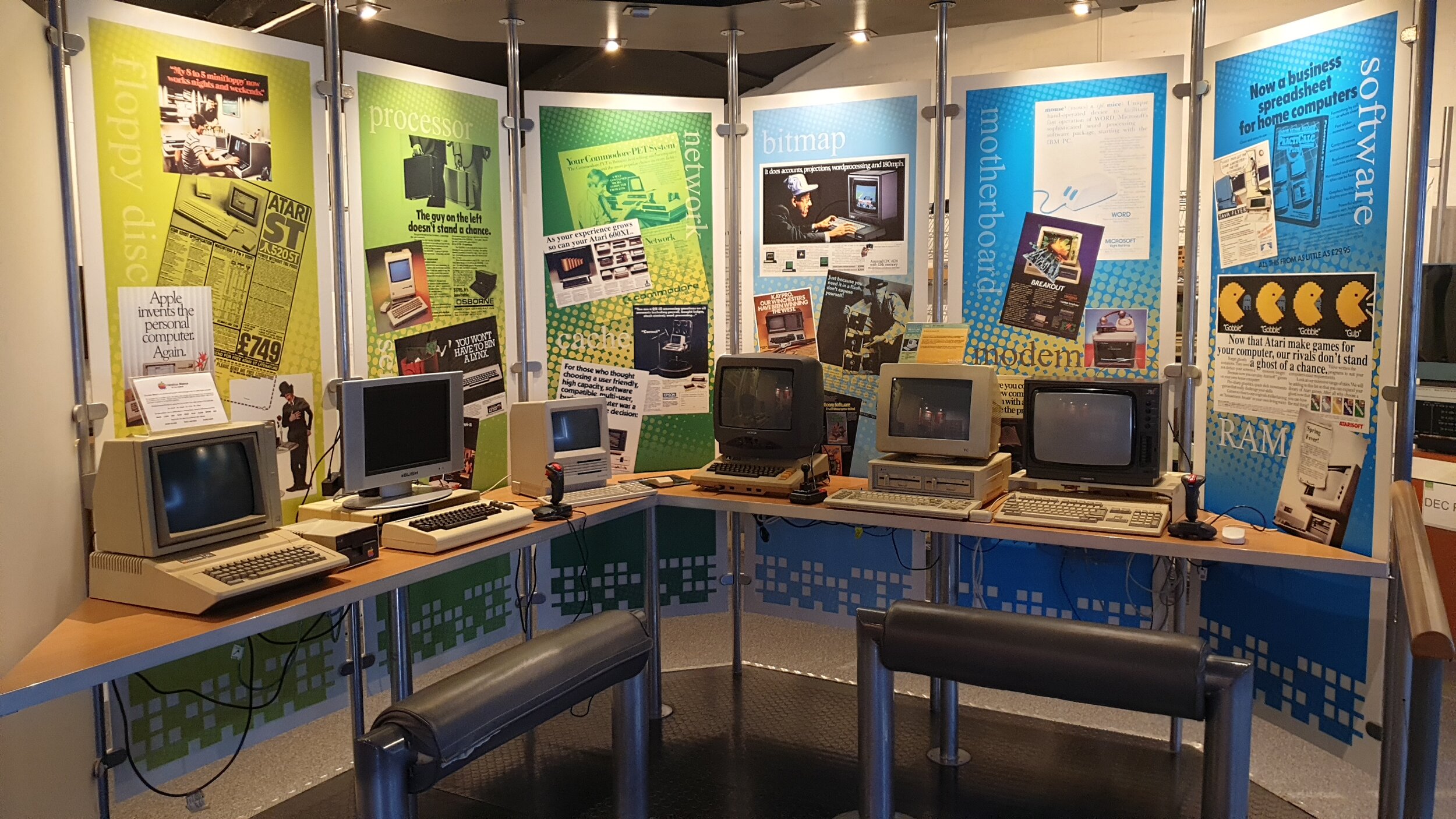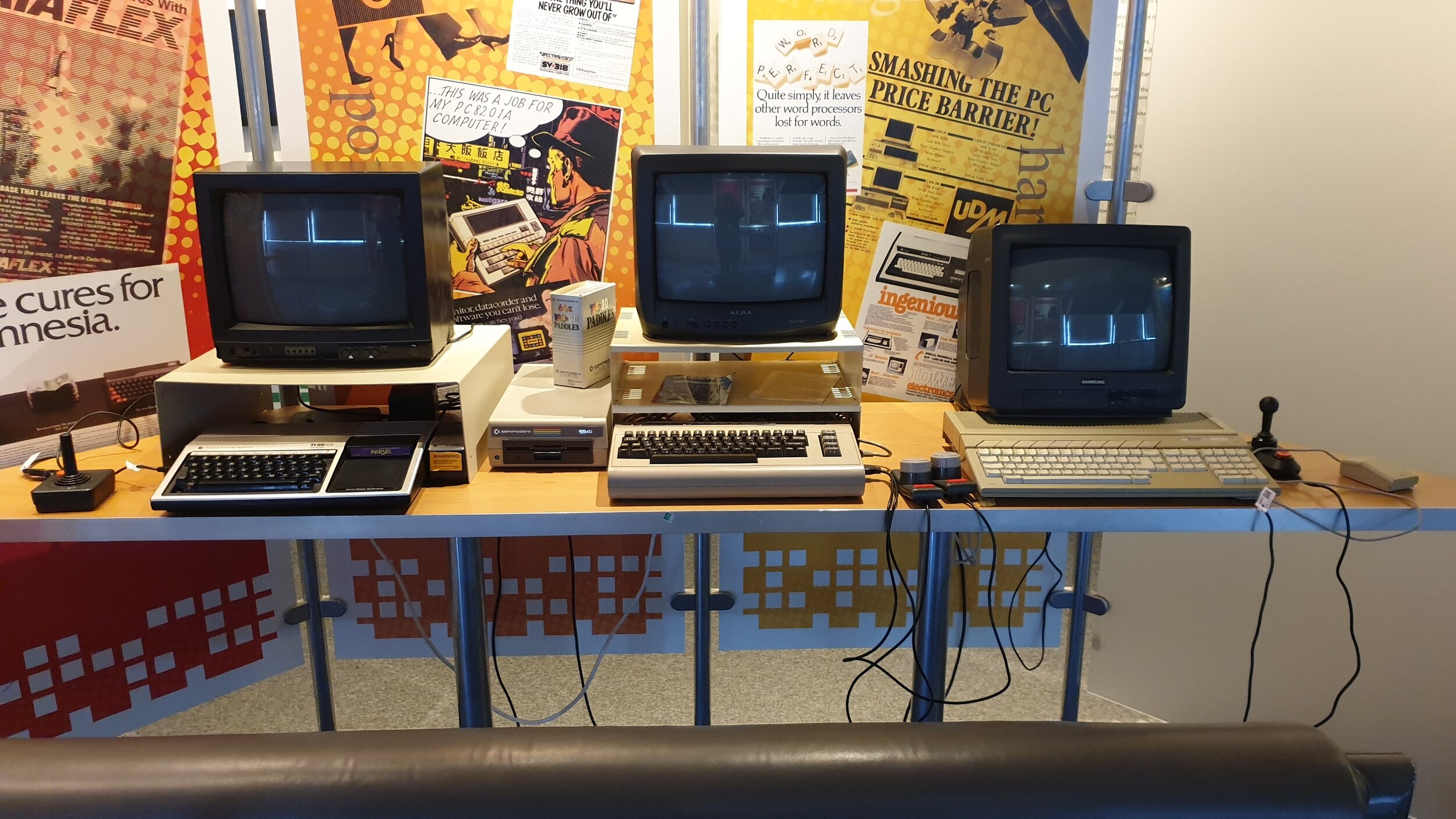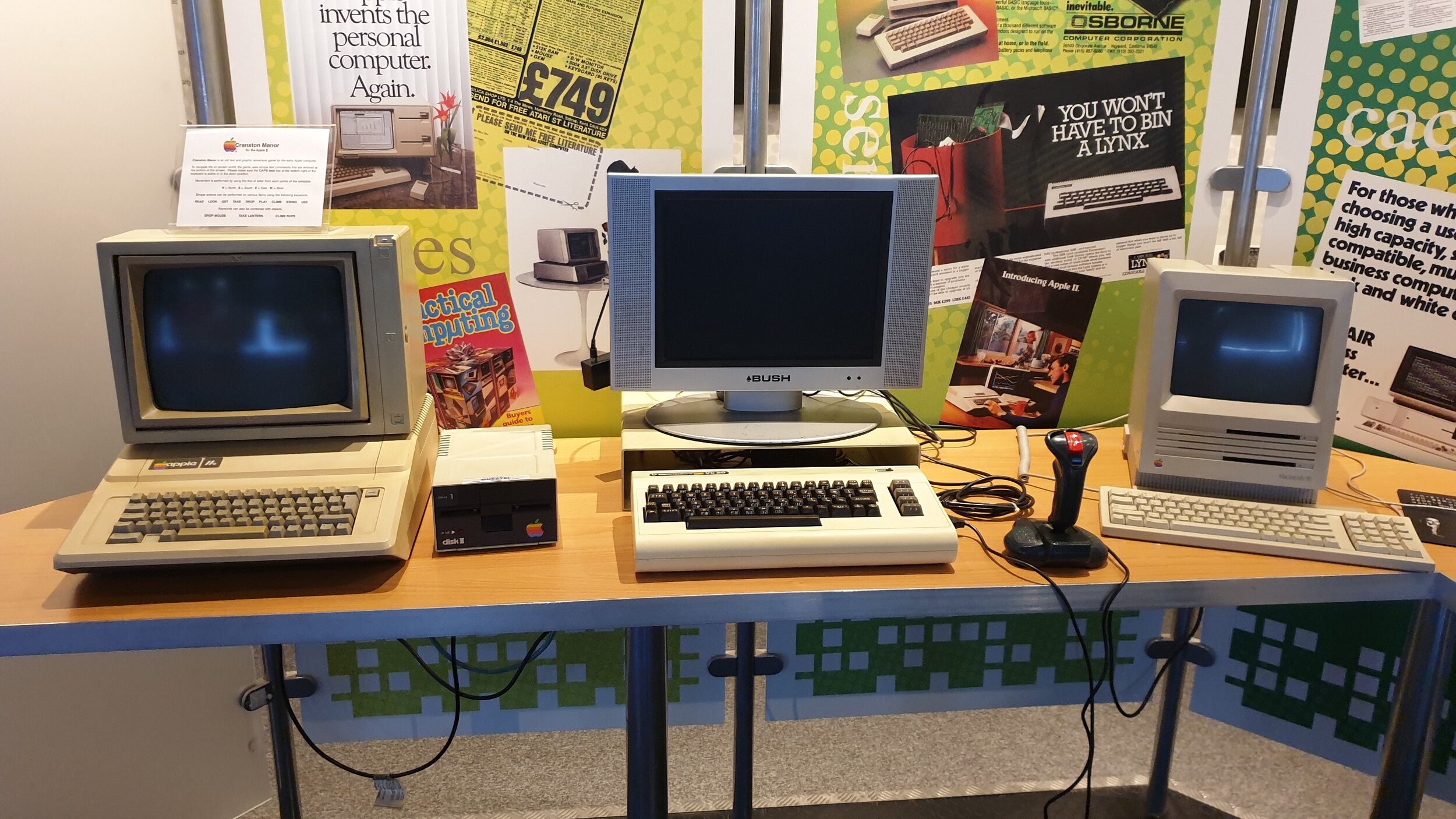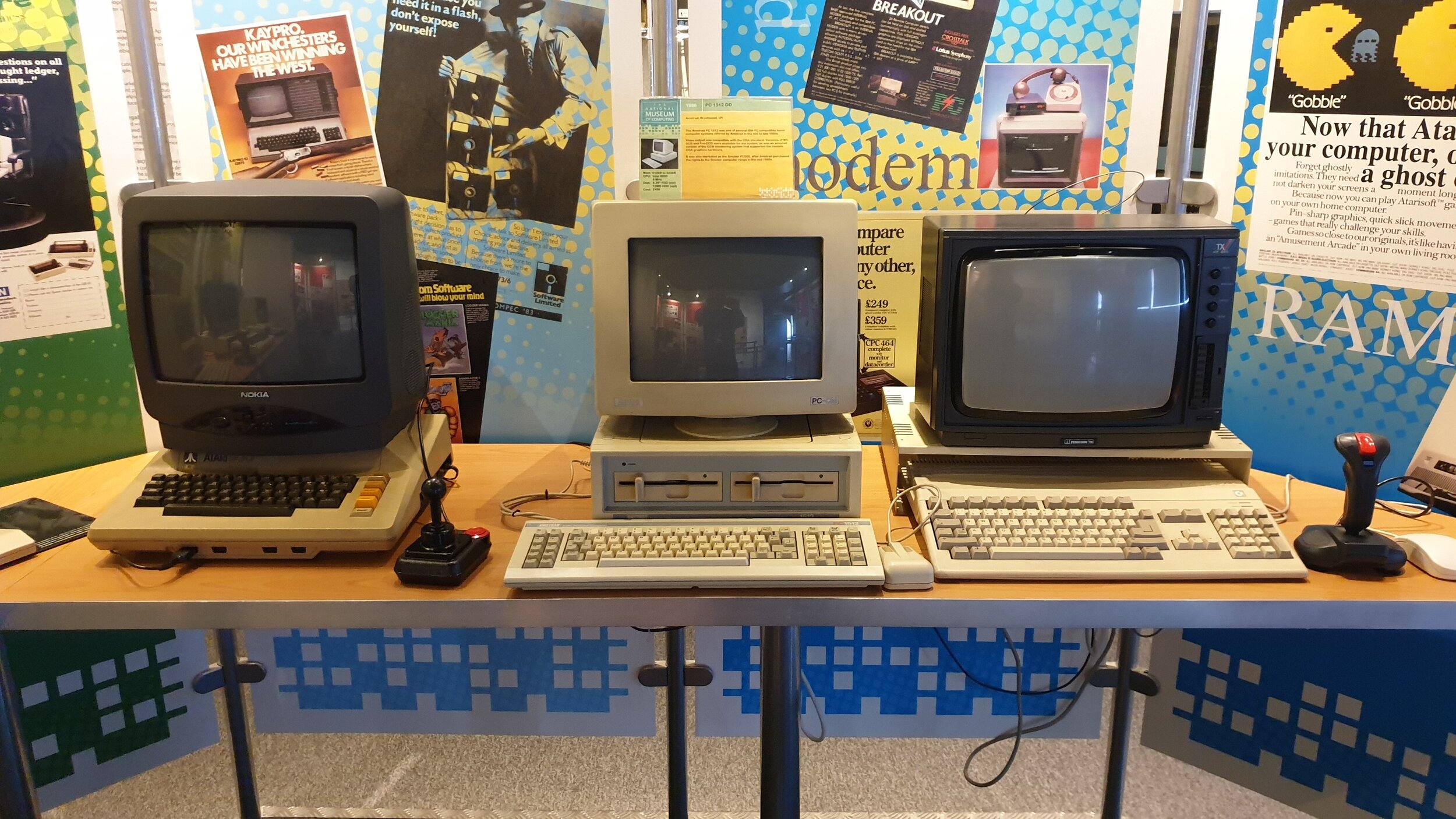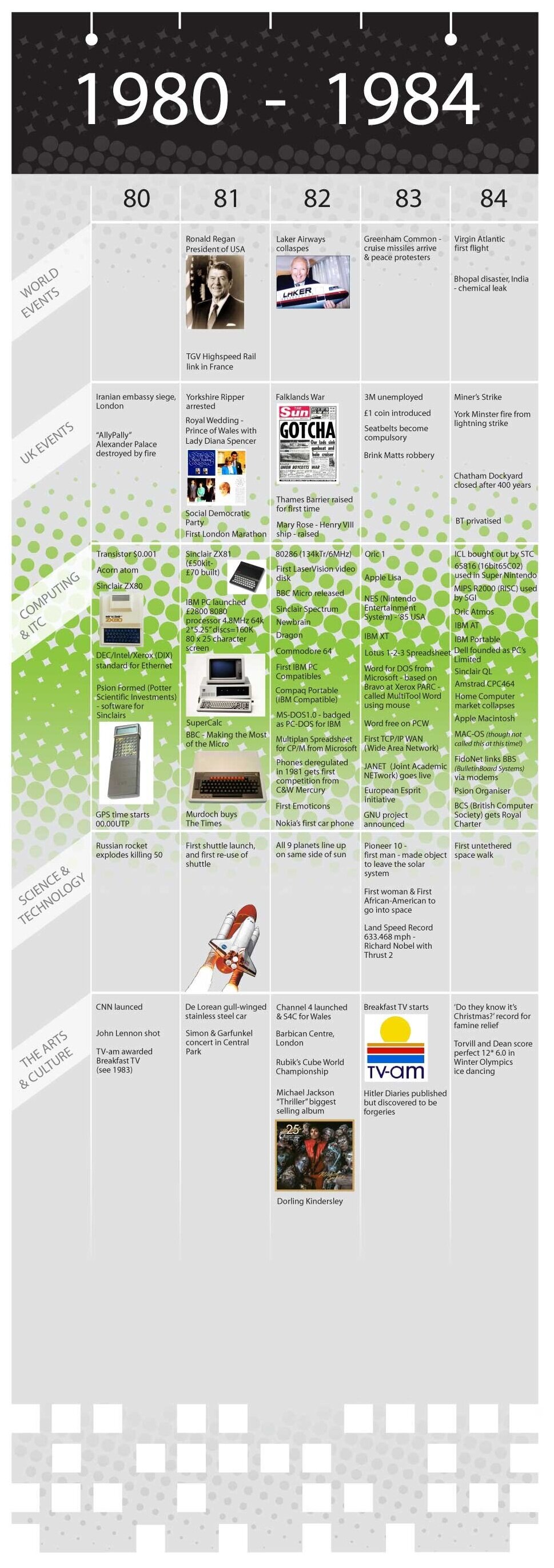Showing a small selection of home, business, portable and pocket sized Personal Computers from the early 1960s to the present day.
The Personal Computer (PC) gallery is one of the popular areas of the museum primarily because you can see many of the familiar home and business computers of the 1980s and 1990s. But most likely because you can also play some of the popular home computer games of the time as well.
The gallery shows many of the areas that computers and computing evolved in:
The early desktop PDP 8 from the 1960s
The start of the microprocessor revolution of early self-build machines from Nascom, Altair, Sinclair
The explosion of the popular home and and business computers from the likes of IBM, Apple, Acorn, Commodore, Atari including the now famous NeXT Cube that started the World Wide Web (not the actual machine, Sadly, but one very similar)
The evolution of portable computers, primarily for business from Osborne, IBM, Keypro, Amstrad and others
Finally showing how the portable computers became the pocket computer with Personal Digital Assistants (PDAs), programmable ‘Calculators’ to the start of the smartphone era when computers more powerful than those of previous generations could fit in your pocket.
It also shows a timeline of events around the gallery showing when some of the key computers were introduced and what world events occurred at the time.
The Beginning
DEC ‘desktop’ PDP8
The first mass produced computer appears in 1965
The Digital Equipment Corporation (DEC) PDP8 or Desktop 8 as it was known, was a personal computer, but few would recognise it as such today
The change in the electronics of computers from valves to transistors enabled lots of transistors to be connected to make a ‘chip’ or ‘Integrated Circuit’.
The PDP8 benefited from this technology by allowing logic boards or ‘flip-chip’ boards as they were known, to be made using transistors, resistors, diodes and capacitors in a much smaller footprint, and allow lots of them to be connected together to make a small, but powerful computer for its day.
The first microprocessor is produced in 1971
Computers with screens (usually TV screens) and keyboards became small enough to fit on or under desktops and with a price tag that individuals could now afford.
Many of the early designs were published in magazines and hobbyists made them at home. Companies such as Nacom were formed who designed and supplied some of the earliest ‘kits’ where you could get the PCB and all the components to build your own 8 bit computer. Often you had to make the case yourself, but other companies were formed who designed and sold cases for these home-built machines, but you will still see many cases made of wood.
The Companies
With the popularity of home-brew kits, and the advance of integrated circuits, a whole industry of small companies started to form to supply ready built kits, peripherals, interface cards, memory expansion cards and much more. As well as the hardware companies, many software and games companies also started to appear to cater for the increasing demand for programs to run on these early machines.
Although many of these early kits used proprietary interfaces, standards also started to appear like S100 bus, which allowed companies to make compatible cards you could buy and make up your system with boards from different manufacturers.Britain had many personal computer companies, at one time in the late 80s this topped over 100. This was the time when some of the well known companies were formed such as Amstrad, Acorn, Sinclair, BBC (yes the BBC, although the BBC Micro was built by Acorn) and RML (Research Machines Limited). But do you remember Apricot, Tangerine, Dragon Data? These are some of the many small British companies that had a short lifespan.
But one other important thing to note about this time, it lead to a generation of skilled IT workers and programmers.
Sinclair: That's Sir Clive Sinclair, an eminent inventor and entrepreneur of the 70s and 80s who formed Sinclair Research. He was one of the first pioneers of the home computer business by designing and selling the ZX80, the first computer for under £100,, although you had to build it yourself for that price. That was soon followed by the ZX81, ready built this time, and then the Spectrum and QLs. He even tendered for the computer to be used by the BBC, but lost out to Acorn. He also designed the first electronic scientific calculators and the famous red led watch.
But his most infamous design was the Sinclair C5 electric 'car', but the less said about that the better. We have a number of Sir Clive's inventions on display for you to play with (this does not include the C5 I'm afraid) and some which are ‘look only’.
But while he was a good inventor, he was not a good businessman and eventually sold his business to Amstrad.
Amstrad: Another of those British success stories was Amstrad, a company founded by Sir Alan Sugar, who introduced the first British designed and built IBM-compatible(ish!) computer in 1986, the Amstrad 1512, for under £500. Unlike the IBM, the Amstrad was aimed at the home market rather than the office and, when first released, they could not make enough to satisfy demand. We have several Amstrad PCs on display and available to use.
Acorn: Did you know that our very own BBC (yes that's the British Broadcasting Corporation) was instrumental in commissioning mass-market computers in the early 1980s?
One of the most iconic home computers of the eighties was the BBC Micro, which found its way into the homes of over 1.5 million people by the time it ceased production in 1986. Starting out as an educational tool for the BBC Computer Literacy Project, it soon evolved into a popular games machine (Elite anyone?), allowing you to build and control a wheeled mouse, to being a fully fledged Domesday laser disk archive system. It is also reported that as late as 2004, a BBC Micro was still being used to steer the 42ft radio telescope at Jodrell Bank.
It found more uses than probably any other system of its time and many a computer programmer of today started with BBC Basic, and dare I say, some still use it today.
Research Machines Limited: RML (now known as RM Plc) is a British company formed in 1973 to provide ‘industry standard’ systems to education. They designed and built their own systems which started with the RML 380Z, a CP/M based system contained in ‘industrial’ black metal cases, which proved very popular, especially when they expanded it to include hard disks and networking, also in similar cases. They further enhanced the range with the Link 480Z, a much smaller, plastic cased version with integrated keyboard, soon followed by their Nimbus range of PC compatible systems. They later ventured into laptops and all-in-one PCs.
RM is still in business, but no longer manufacturing their own hardware.
Hardware Takes Off
IBM PC
NeXT cube
IBM Dominates
IBM soon realises that Microcomputers are threatening their market, so they develop their own Personal Computer and publish much of the specification. Soon this standard is copied by others and PC-compatible computers come to dominate the market
The period sees exiting developments in hardware, but the future of the Personal Computer is led by IBM and Apple.
IBM verses the rest
In the USA the main battle is between IBM and Apple. However, in the UK there is a wider range of computers, especially home computers. The IBM PC has to compete with these and then the PC-compatibles. This meant it was much harder to ‘break in’ to the UK market.
IBM decides it can best win market share by using an Open Architecture to encourage third parties to produce peripherals and software. Arguably this helps other third parties to reverse engineer the system and produce compatibles but also increases the market for such systems and thus IBM could sell more hardware as a result.
How to make a clone - legally!
A computer is usually supplied with standard program routines to make it work. These are stored in the BIOS.
A programmer can call on these routines to control the machine. These routines accommodate differences in hardware and help application programmers further by ensuring any code they write would work on any PC that was ‘compatible’.
For the genuine IBM PC these BIOS routines were copyright! To get around the copyright, a company has to develop their own routines that behave in the same way and be able to prove they have not copied the original.
These BIOS routines became key to the PC operation, and while the bigger companies like IBM, HP developed their own, a market soon developed and companies such as Phoenix Technologies and American Megatrends (AMI) started to appear who could develop BIOS routines for all sorts of computers.
Carrying it Everywhere
Desktops with a Handle
The decreasing size of Personal Computers makes it possible to design machines for carrying between home and work, but in time it also became a valuable tool for those that are ‘on the road’ like service engineers and salesmen, who could take their office with them or have access to technical information.
It also introduced the ‘all-in’one’ concept of PC, screen and keyboard combined into a single case.
Two of the early companies in this field were KeyPro and Osborne, who both made machines with computer screens, keyboards and disk drives in a single case. While they were portable, they were still heavy and power hungry so still needed a mains supply to operate - to supply a battery at this time was impractical as it would have needed a separate and much bigger, heavier case to carry it, and still need charging.
Laptops
As the technology improved and things got smaller the ‘lugable’ PC started to become smaller, lighter much port portable
LCD Flat-Screens were developed which were less bulky, were lighter, did not need to depth that a CRT screen needed (which limited the screen sizes in the early models, and they used much less power
Disk drives, processors and other components got smaller and were designed to use lower voltages and much less power.
Battery technology improved allowing smaller battery cells to store more power, take up less room and weight less.
Mouse functions could be done with other devices including trackballs, swipe pads, nipples
Now a computer could be the size of a briefcase and with batteries, can even be used while travelling.
The British Contribution
Early Acorn computers are based on the simpler 6502 chip rather than a more complex processor. A fast simple processor can be as effective as a more complex, slower one.
Acorn used this principle to design a Reduced Instruction Set Computer - the Acorn RISC Processor or ARM - which proves o be fast, requiring little electrical power and is ideal for portable computing.
Apple collaborated with Acorn and release the Apple Newton PDA (Personal Digital Assistant) which used the ARM chip.
The ARM chip is now the dominant processor in the handheld computer and phone market.
Everything in your pocket
PDA - Personal Digital Assistant
In 1983, a pocket calculator that can store a database of addresses first appears.
Other companies start to produce handheld computers with miniature keyboards that can be a calculator or a database and can also be programmed.
In 1992, Apple coins the phrase Personal Digital Assistant (PDA) for the Newton which had a touch sensitive screen and handwriting recognition.
Computers in Everything Mobile
The new century sees digital technology included in all sorts of handheld devices:
Phones, PDAs, portable game players, cameras, TVs, mp3 players, DVD players, Satellite Navigation devices
The improvement in touchscreens, handwriting and speech recognition bring a whole new stream of features.
Memory cards get smaller and capacity increases ten fold allowing more data to be stored, thus allowing improvements in things like camera technology allowing more detail to be captured.
All together!
Eventually the limiting factors became the size of the human hand, the size of screen for visibility and their convenience of having all these digital devices separate (phone, camera, PDA, calculator etc)
So the eventual result becomes the smartphone, which is the digital device that becomes the standard for portable computing.
Hands-On Computers
No gallery on Personal Computers would be complete without some hands-on examples. So we have put a number of working machines on display for you to have a play with. Of course as most of these are home computers, we have set up some of the more well known and popular games for you to play.
Above the machines are a number of boards showing adverts for some of the computers in the 80s and 90s.
And yes, we also have arcade games
While not actually in the PC gallery, we also have two 1980s period arcade games near by; Space Invaders and Crazy Taxi.
Along side the arcade games, are some of the more popular home games consoles from Sony, Nintendo, Microsoft, Atari and others which always prove popular with the kids (both large and small!).
Computing Timeline
The boards surrounding the hands-on systems show a timeline of computing from the early 1960s to 2009, when the gallery was completed. This shows over a number of boards events that took place and what computers were introduced at the time.




